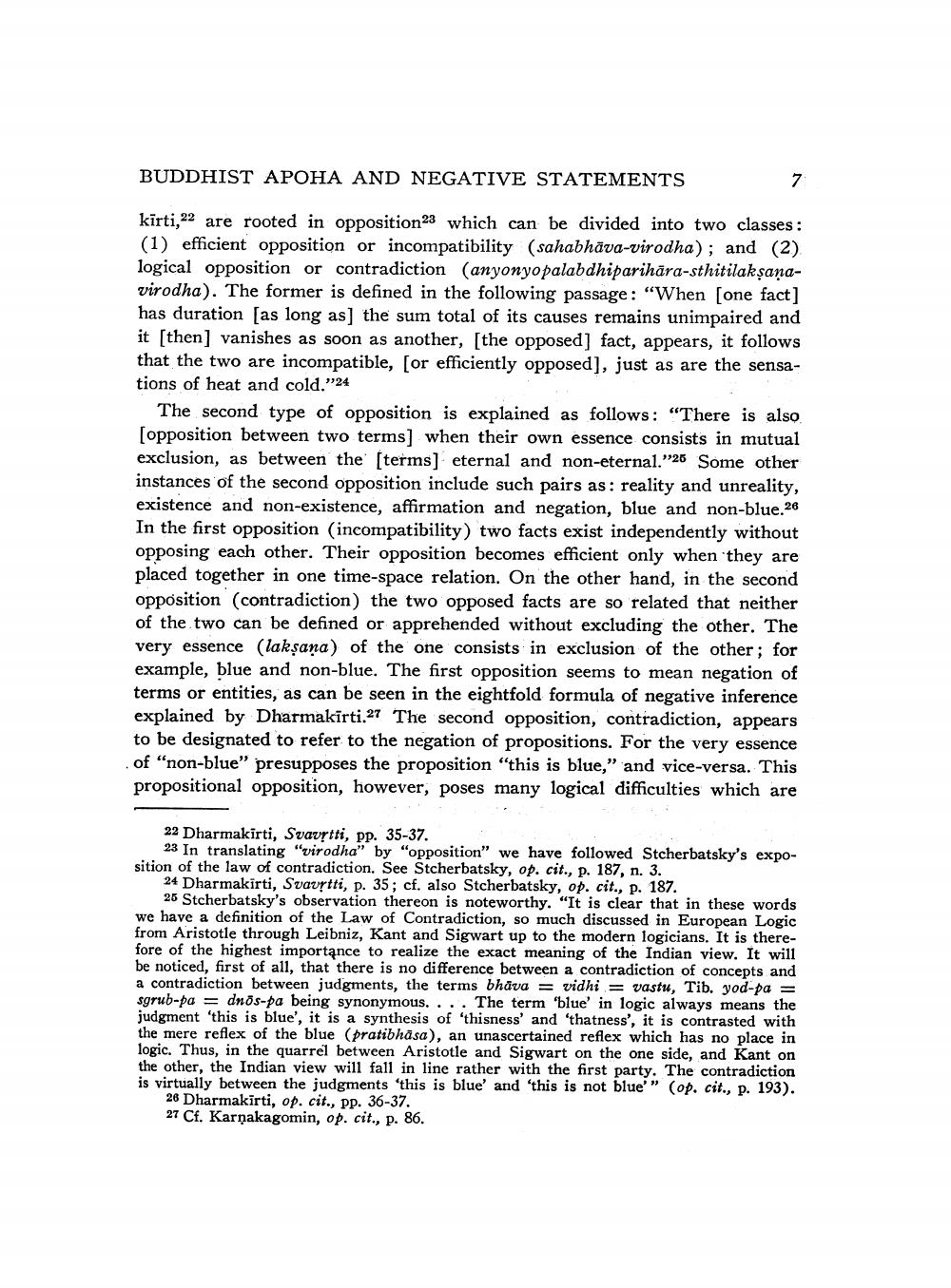Book Title: Buddhist Theory Of Meaning Apoha And Negative Statements Author(s): Dhirendra Sharma Publisher: Dhirendra Sharma View full book textPage 5
________________ BUDDHIST APOHA AND NEGATIVE STATEMENTS 7 kīrti, 22 are rooted in opposition 23 which can be divided into two classes: (1) efficient opposition or incompatibility (sahabhāva-virodha); and (2) logical opposition or contradiction (anyonyopalabdhiparihāra-sthitilaksanavirodha). The former is defined in the following passage: "When [one fact] has duration (as long as] the sum total of its causes remains unimpaired and it (then) vanishes as soon as another, [the opposed] fact, appears, it follows that the two are incompatible, (or efficiently opposed), just as are the sensations of heat and cold.”24 The second type of opposition is explained as follows: "There is also (opposition between two terms] when their own essence consists in mutual exclusion, as between the [terms] eternal and non-eternal.”26 Some other instances of the second opposition include such pairs as: reality and unreality, existence and non-existence, affirmation and negation, blue and non-blue.26 In the first opposition (incompatibility) two facts exist independently without opposing each other. Their opposition becomes efficient only when they are placed together in one time-space relation. On the other hand, in the second opposition (contradiction) the two opposed facts are so related that neither of the two can be defined or apprehended without excluding the other. The very essence (laksana) of the one consists in exclusion of the other; for example, blue and non-blue. The first opposition seems to mean negation of terms or entities, as can be seen in the eightfold formula of negative inference explained by Dharmakirti.27 The second opposition, contradiction, appears to be designated to refer to the negation of propositions. For the very essence of "non-blue" presupposes the proposition "this is blue," and vice-versa. This propositional opposition, however, poses many logical difficulties which are 22 Dharmakirti, Svavrtti, pp. 35-37. 23 In translating "virodha" by "opposition" we have followed Stcherbatsky's exposition of the law of contradiction. See Stcherbatsky, op. cit., p. 187, n. 3. 24 Dharmakirti, Svavrtti, p. 35; cf. also Stcherbatsky, op. cit., p. 187. 25 Stcherbatsky's observation thereon is noteworthy. “It is clear that in these words we have a definition of the Law of Contradiction, so much discussed in European Logic from Aristotle through Leibniz, Kant and Sigwart up to the modern logicians. It is therefore of the highest importance to realize the exact meaning of the Indian view. It will be noticed, first of all, that there is no difference between a contradiction of concepts and a contradiction between judgments, the terms bhāva = vidhi = vastu, Tib. yod-pa = sgrub-pa = dnös-pa being synonymous. ... The term 'blue' in logic always means the judgment 'this is blue', it is a synthesis of 'thisness' and 'thatness', it is contrasted with the mere reflex of the blue (pratibhasa), an unascertained reflex which has no place in logic. Thus, in the quarrel between Aristotle and Sigwart on the one side, and Kant on the other, the Indian view will fall in line rather with the first party. The contradiction is virtually between the judgments 'this is blue' and 'this is not blue'” (op. cit., p. 193). 26 Dharmakirti, op. cit., pp. 36-37. 27 Cf. Karņakagomin, op. cit., p. 86.Page Navigation
1 ... 3 4 5 6 7 8
